Justin’s Japan: Interview with Tak Matsumoto and Koshi Inaba of B’z on the Live-Gym 2012 Tour
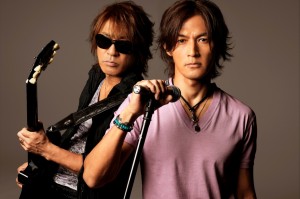
Tak Matsumoto, left: “This tour is going to be the fourth tour in the U.S. for B’z. I always love to play in the U.S., and I felt we should release English songs for the American audiences. The show will be a mix of both Japanese and English.” (Vermillion)
By JQ magazine editor Justin Tedaldi (CIR Kobe-shi, 2001-02) for Examiner.com. Visit his Japanese culture page here for related stories.
The most successful group in Japanese history, B’z have sold 80 million records since their 1988 debut, and also have released a staggering 46 consecutive number one singles. Comprised of Grammy-winning guitarist Tak Matsumoto and ace vocalist Koshi Inaba, the rock duo has flirted with American success in the past, launching three of their Live-Gym West Coast tours in the last decade.
Now, B’z is ready for a full-scale American invasion, launching their first-ever national tour beginning in San Francisco Sept. 17 and hitting New York’s Best Buy Theater Sept. 30. At the same time, the band is promoting its debut English-language digital EP entitled B’z, which features five of the stadium act’s biggest hits made for a whole new audience.
In this exclusive interview, I caught up with Tak and Koshi on why the band waited until now to do a coast-to-coast tour, their experience working with other rock luminaries like Aerosmith and Linkin Park, and the plans in motion for the band’s 25th anniversary next year.
Let’s start with the basics. How did the band get its name?
Tak: I don’t remember exactly. We probably thought we needed to have a simple name that was easy to memorize.
Koshi: We wanted a short name—like a code. At first, it was AZ, which came from an A to Z kind of meaning, but we didn’t like how it was pronounced. Then we changed it to B to Z, and liked how it sounded.
Why has B’z decided to finally play New York now?
Tak: I don’t know exactly why it took so long, but I’ve been waiting to perform there. I’m really looking forward to it.
Koshi: When we started performing in the U.S., most of our dates were on the West Coast. We weren’t familiar enough with New York to have a show there.
Tell us about the other musicians you’re performing with on this tour.
Tak: Takanobu Masuda is on keyboards. He’s my old friend, and has been performing with B’z for 20 years. Shane Gaalaas is on drums. He’s played with Michael Schenker, Yngwie Malmsteen and many others. He also has his own band, Cosmosquad. Barry Sparks is on bass. He also played with Michael and Yngwie, along with Ted Nugent, UFO and the Scorpions as well. Yoshinobu Ohga is on guitar. He was on our last tour of the U.S. I’m supported by his perfect harmony.
Koshi: Ohga joined last year. Everyone else has been touring with B’z for a long time, and they’re all great.
What can we look forward to at these shows?
Tak: We are going to the East Coast for the first time, but this tour is going to be the fourth tour in the U.S. for B’z. I always love to play in the U.S., and I felt we should release English songs for the American audiences. The show will be a mix of both Japanese and English.
Koshi: We’re looking forward to the U.S. audience hearing our new English songs. You might sweat a lot at our show, but you’ll enjoy it!
Is this new EP part of a plan to release a full English-language album in the future?
Tak: I hope so.
For the complete interview, click here.
JQ Magazine: JQ&A with Paige Cottingham-Streater, Executive Director of the Japan U.S.-Friendship Commission
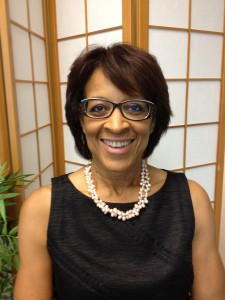
“It’s impressive to see not only the countries and communities from which JET alumni herald, but also the ways in which they contribute to the program during and after their involvement. The Japanese government should certainly be pleased with the return on its investment in introducing so many people to Japan.” (Courtesy of JUSFC)
By Renay Loper (Iwate-ken, 2006-07) for JQ magazine. Renay is a freelance writer and associate program officer at the Japan Foundation Center for Global Partnership. Visit her blog at Atlas in Her Hand.
Paige Cottingham-Streater (Mie-ken, 1988-89) is a co-founder of the JET Alumni Association and executive director of both the Japan-U.S. Friendship Commission (JUSFC), a federal agency that provides grants for research, training and exchange with Japan, and the United States-Japan Conference on Cultural Interchange (CULCON), a binational advisory panel to the U.S. and Japanese governments
Cottingham-Streater previously served as deputy executive director of the Maureen and Mike Mansfield Foundation, where she worked for 16 years. In 2004, she received the Japan Foreign Minister’s Commendation in recognition of her longstanding work to strengthen U.S.-Japan relations. The award commemorated the 150th anniversary of the Treaty of Peace and Amity between Japan and the United States.
A regular on the U.S.-Japan relations conference circuit in the United States and abroad, Cottingham-Streater spoke with JQ recently to discuss her rich career, advice for today’s JETs, and thoughts about the future between America and Japan.
What initially sparked your interest in Japan?
My father served in the Korean War and spent time in Japan, so I was initially introduced through his recollections of the history and phrases he learned. In 1970, I was an elementary school student and Japan was hosting the World Exposition in Osaka, so my family traveled [there] to attend the expo and experience Japanese culture. As a young person, I was interested in the similarities and differences between Japan and the U.S. We arrived in Tokyo and saw department stores and familiar automobiles, but there were distinct and subtle differences, such as language spoken and [the] size of automobiles. I returned home wanting to learn more, so in high school I took an Asian Studies class. As a freshman in college, I took another Asian studies class and then more Japanese studies classes [ultimately leading to a] double major in Asian Studies and Government, with the goal of becoming a lawyer who could build a career involving Japan.
JETAA began in 1989. What was your personal motivation for creating the organization?
I’d had a wonderful and rewarding year in Japan that I didn’t want to end completely when I returned to the U.S. I also wanted to find some small way to repay the generosity I had received from the community and country that hosted me. Before departing Japan, several of us who were not renewing met to explore ways in which we could stay connected with each other and support the program by recruiting others and sharing information about Japan. There were a handful of us who were returning to different parts of the United States so we decided Washington, D.C. should be the central focus. When I returned to D.C., I contacted the Japanese embassy about the possibility of working with them as well as the JET office to hold meetings and build a mailing list.
How many other people did you co-found it with?
I found four others in Washington, D.C. who had also recently returned. California, New York, and Philadelphia quickly grew shortly thereafter.
Where would you like to see JETAA go?
I’d like to see JETAA build an infrastructure and organize itself in a way that allows the organization to operate as a single entity, with chapters serving the unique needs of local communities in the U.S. and overseas.
JQ Magazine: Book Review – ‘Heart of a Samurai’
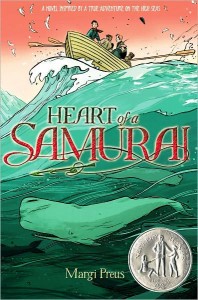
“Many people join the JET Program looking to form international bonds between their home countries and Japan, but Manjiro Nakahama faced bigger challenges into trying to end Japan’s isolationist policy. ‘Heart of a Samurai’ gives you a fun glimpse of one of Japan’s most important historical figures.” (Abrams)
By Rashaad Jorden (Yamagata-ken, 2008-2010) for JQ magazine. Rashaad worked at four elementary schools and three junior high schools on JET, and taught a weekly conversion class in Haguro (his village) to adults. He completed the Tokyo Marathon in 2010, and was also a member of a taiko group in Haguro.
You might know that under the policy of sakoku, no Japanese were permitted to leave the country. So when Japanese people were finally able to do so, it must have been a fascinating story. And thanks to Margi Preus, people have an easy-to-read tale about one of the first Japanese to venture outside of the country’s borders.
Preus’ book Heart of a Samurai offers a look into the life of Manjiro Nakahama, a fisherman-cum-aspiring samurai whose life is turned upside down when his boat is shipwrecked during an 1841 fishing trip. He and his four comrades are stranded on a remote island until members of an American whaling vessel arrive.
It was aboard the John Howland that Manjiro first learned about a world previously foreign to him. Unlike his comrades, the ever-inquisitive Manjiro is not scared of “butter stinkers” (a derogatory term for foreigners) and he learns English so quickly, he forms a bond with ship captain William Whitfield. Whitfield eventually takes Manjiro back to the United States, where the young man lives with the captain’s family. After spending several years exploring the world by sea, Manjiro eventually returns to Japan to accomplish his goal.
This book will resonate with people because it addresses the theme of being shocked at the world’s differences—some of which are hilarious (Aboard the John Howland, Manjiro is stunned by the existence of buttons, pockets, forks and knives while later expressing similar astonishment by seeing men wearing watches) and some that are not so funny (Manjiro is stunned to see segregation in a church). And in addition to adjusting to a culture where everything seemed to changing, Manjiro must also tackle racism and a new language while working to prove himself to people in a new country.
Justin’s Japan: Nippon in New York — B’z, Books, Sake Tastings and Michael Jackson in Yokohama

B’z, the biggest-selling musicians in Japanese history, will make their New York debut at Best Buy Theater Sept. 30. (Courtesy of Best Buy Theater)
By JQ magazine editor Justin Tedaldi (CIR Kobe-shi, 2001-02) for Examiner.com. Visit his Japanese culture page here for related stories.
After you’ve rested up from Labor Day weekend, enjoy the sights, sounds and tastes of Japan with a whole month’s worth of events, activities and products from musicians to authors to restaurants. It’s all happening here as we welcome another autumn in New York.
Tuesday, Sept. 4, 6:00 p.m.-8:00 p.m.
Oze no Yukidoke from Ryujin Shuzo Sake tasting
Sakaya
324 East 9th Street
Hailing from Gunma prefecture, Oze-no-Yukidoke is a well-refined sake that is widely considered to be one of the finest sakes available. Join Mr. Hideki Horikoshi, the head sake brewer of Ryujin Shuzo, for his his handmade signature sake, Oze no Yukidoke Junmai Daiginjo, as well as Ohkarakuchi Junmai. Purchasers will receive a lacquered sake cup as a free gift!
Sunday, Sept. 9, 1:00 p.m.
Cultural Resource – Contemporay Music by Japanese Composers/Musicians
Scandinavia House
58 Park Avenue
“The influences of ethnicity on the musical idioms of contemporary composers” is the research subject of Akiko Asai, Visiting Scholar at New York University. This concert is held as a part of her research project and a wrap-up of her research term at NYU and features Japanese composers and their works. The audience will be able to not only meet these artists’ creativities but also listen to the result of their research through the identical sound of accordion. Tomomi Ota, who will play their pieces, is a one of the promising performers who can show the audience different perspectives vividly.
For the complete story, click here.
Justin’s Japan: Interview with ‘Speed Tribes’ Author/JET Alum Karl Taro Greenfeld
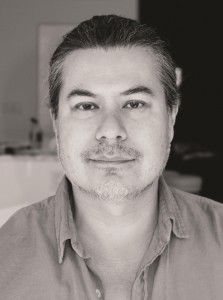
“From being born in Kobe and spending time in Japan as a child, I had a decent feel for Japanese culture and even a little bit of the language. But what best prepared me for the JET Program was living in Paris during my junior year in college; that familiarized me with living in a foreign country and how one had to adapt, especially back then in pre-Internet times.” (Esmee Greenfeld)
By JQ magazine editor Justin Tedaldi (CIR Kobe-shi, 2001-02) for Examiner.com. Visit his Japanese culture page here for related stories.
Born in Kobe and raised in America, Karl Taro Greenfeld (Kanagawa-ken, 1988-89) is the author of six books, and over the past two decades his writing has graced everything from the Paris Review to Playboy to Time Asia (where he served as editor for two years). His first book was Speed Tribes: Days and Nights with Japan’s Next Generation, a gritty, true-life portrait of Tokyo’s urban underground. Published in 1994, it exposed a fascinating side of post-bubble Japan rarely seen (or reported by) foreigners.
Now living in Tribeca with his wife and two daughters, Greenfeld has recently penned his debut novel, Triburbia, which once again finds a muse in his current milieu. The New York Times calls it “an artful and casually cohesive work of fiction imbued with anthropological insight,” and Greenfeld will be appearing at an author event at (where else?) Barnes & Noble Tribeca on Sept. 5.
In this exclusive interview, I spoke with Greenfeld about his early days in Japan during its economic peak, his highlights as a journalist covering the nation’s subculture, and a never-before-told story about the fate of a planned Japanese-language release of Speed Tribes.
Triburbia is a story about Tribeca fathers at the end of the last decade facing a changing neighborhood, which is similar to your own life. What made you to decide to write a novel about this?
I was living in Tribeca and then we moved to Pacific Palisades, California for a few years, and that caused me to look back at Tribeca and think about that time and place. It’s very similar to how I wrote Speed Tribes after moving from Japan back to the U.S. Somehow, when I am living in a place the intensity of experience makes it hard to write about. But with the perspective of distance, ideas come into focus and I can get a better idea of what I want to say about a place.
At 23, you served on the JET Program in Kanagawa Prefecture from 1988-89. How did JET come on your radar, and what kinds of jobs did you have before that?
I don’t remember how I heard about JET. I think it was something my mother found out about and passed on to me through her contacts at the Japanese Consulate in Los Angeles. Before that I was working in a clothing store and was just starting to write for magazines. I’d had small stories in the New York Times and Harper’s Bazaar and I already knew that’s what I wanted to do. But then I was accepted into the JET Program, which turned out to be a lucky break because it got me to Japan, though further from Tokyo than I would have liked.
You were born in Kobe, grew up in Los Angeles and went to college in New York. How did this exposure to different cultures and lifestyles prepare you for your time on JET?
From being born in Kobe and spending time in Japan as a child, I had a decent feel for Japanese culture and even a little bit of the language. But what best prepared me for the JET Program was living in Paris during my junior year in college; that familiarized me with living in a foreign country and how one had to adapt, especially back then in pre-Internet times. I remember getting theJapan Times every day and that was my only connection to what was going on in America, a few baseball results—they didn’t print box scores—and maybe a few AP stories picked up about Bush or Dukakis. That was it!
How about being perceived as “half-Japanese” or “Asian” during your time in Kanagawa?
I think being half-Japanese was actually a disadvantage in the JET Program. For one thing, when Japanese kids hear they are getting a foreign teacher, they want a foreign teacher: A tall, strapping, blonde, preferably female, would be ideal. When I showed up, looking Japanese, I think it was a little bit of a disappointment. Never mind how lousy a teacher I actually was.
What were the biggest life lessons you picked up from JET? How about from that first year from working in Japan?
I learned a few things: For one, I learned that I shouldn’t confuse loneliness and happiness. That sometimes, I could be very lonely, and for the first six months or so in Kugenuma, where I lived in Kanagawa, I was intensely lonely. But I was strangely productive. I wrote a novel (never published), read a few hundred books, and had a lot of time to think about writing and what I wanted to say. It was the first time in my life that I wrote every day for a year.
For the complete interview, click here.
By Preston Hatfield (Yamanashi-ken, 2009-10) for JQ magazine. Preston moved from San Francisco to New York City in January 2012 and is now accepting submissions from people who want to be his friend. Abduct him from his house in the middle of the night, or find him on Facebook and ask about his JET blog in which he details his exploits and misadventures in that crazy Land of the Rising Sun we all love.
If you have been back from JET for a year or two, you probably already know the story. If you are just now returning and you have not been keeping up with the news, let me fill you in: The economy, well, it sucks. And while that fact may not exactly be news considering that the markets crashed back in 2008, it is very possible, especially for those who have lived abroad since then, that the recession has not affected you yet. But according to the Wall Street Journal, with 8.2 percent unemployment, an additional 88 million unemployed Americans not a part of that calculation due to having stopped actively searching for jobs, and three consecutive lackluster jobs reports coming out of Washington in the past months (which according to the Journal makes this the “weakest quarter for job growth since the labor market began to recover in 2010”), returning expats are in for a rude homecoming.
Speaking from experience, the generous salary and benefits JETs enjoy seems like a well that will never run dry, and when I came home in the summer of 2010 and bounced between part-time jobs, internships, and temporary positions for the better part of two years, I was kicking myself for walking away from a guaranteed contract in Japan before my limit was up. If I could do it again, they would have to drag me onto that America bound plane kicking and screaming.
I am writing mainly to the JETs who are coming home this year—more specifically, to young JETs who will be making their valiant attempts to join the American workforce for the first time since graduation— and please know that I am not trying to scare you. Hey, you survived teaching in Japanese classrooms, nothing can scare you anymore. But I am here to warn you that the road ahead may be rough, and you would be wise to manage your expectations when you decide to start your next job search. It can be stressful. On top of the reverse culture shock and post-JET depression that some of you will experience, the added pressure of needing a job and the frustration of sending out résumé after résumé without response can bring you down and tempt you to sign on with whatever Japan teaching pops up on a Google search. I trust that you and I are not the only ones who have felt this way, but before you do that, take a step back and consider your other options.
Hopefully, as you are readjusting to life in the States you will be formulating a rough game plan for the challenge ahead, but if you do not already have a field that you are determined to break into, if grad school is not yet on your radar, and if you really want to strengthen your understanding of Japan and maintain your connection to Japanese culture, then perhaps working at a Japanese company in America is an option. There are a handful of established Japanese staffing agencies with offices throughout America’s major cities that place people in a variety of full and part-time positions. But do these companies want to interview, much less hire, former English teachers such as ourselves? I caught up with a recruiter in Midtown Manhattan to find out.
Justin’s Japan: Interview with Minoru Niihara of Loudness on ‘Eve to Dawn’
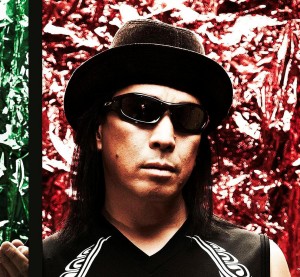
“Compared to the ‘80s, record labels, media and music industry are totally different now, but rock bands’ success has been always written on the stage. I believe that rock bands should live on the stage and that’s the most legitimate way to do our job.” (Courtesy of FrostByte Media)
By JQ magazine editor Justin Tedaldi (CIR Kobe-shi, 2001-02) for Examiner.com. Visit his Japanese culture page here for related stories.
In the beginning, there was Loudness. Formed in 1981 in Osaka, the Japanese quartet started out as a successful hard rock and metal outfit and expanded their fanbase to America four years later with an international album deal and hit single “Crazy Night.”
History is now repeating itself. Twenty-five years after the release of original frontman Minoru Niihara’s last album with the group during their ’80s heyday, Loudness has now inked a new global record deal with FrostByte Media to reintroduce them to a new audience outside of Japan. First up is the newly released studio album Eve to Dawn—their 26th overall—and a fall North American tour is in the works.
In this exclusiveinterview, I caught up Loudness’ charismatic vocalist to discuss opening for Mötley Crüe at Madison Square Garden, the similarities between Japanese and American groupies, and which heavy metal movie makes him cry.
Eve to Dawn was released last year in Japan. Are there any differences between the original version and the American release?
I don’t have a copy here yet, but I don’t think there’s any difference between the two.
Are there any plans for your new label to release your most recent album, 2012, which also just came out inJapan?
It’ll be released next year.
For those unfamiliar with the band, how would you describe Loudness’ sound and lyrical themes?
It’s a very unique hard, heavy and explosive, Asian metal rock band. The most recent album has lots of songs with positive and encouraging messages because of the quake in 2011.
What made you want to become a rock singer?
When I was about 15, there is a cool singer named Masaki Ueda in Osaka, and because I really liked him, I got interested in singing. After a while I found joy in singing when I learned that people loved to listen to me sing. I became a pro, one synchronicity after another.
In a recent interview with New York’s own Chopsticks magazine, the band mentioned that its main goal now is to become a success in the U.S. What plans do you have to achieve this?
There is nothing but touring and doing lots of live performances, I guess. I believe that rock bands should live on the stage and that’s the most legitimate way to do our job. That’s our policy!
For the complete story, click here.
JQ Magazine: Book Review – ‘Orchards’ Is Elegant, Powerful, Profound

“‘Orchards’ is at once a celebration of life and a somber reflection on the choices we make and their often irrevocable consequences.” (Random House)
By Sharona Moskowitz (Fukuoka-ken, 2000-01) for JQ magazine. Sharona is interested in fresh, new voices in fiction and creative nonfiction.
Meet Kanako Goldberg. Half Japanese, half Jewish, the teenage narrator of Holly Thompson’s breathtaking 2011 novel Orchards is more bagels and lox than natto and rice. After the suicide of her classmate in New York, Kanako is sent by her Japanese mother to spend the summer with her relatives on their mikan farm in a rural village tucked beneath the shadows of Mount Fuji. The trip to Japan is not only a chance to bond with her Japanese kin, it’s something of a temporary exile, a time to reflect on her life and her classmate’s untimely death at a safe geographical remove.
The victim’s name was Ruth and she is evoked repeatedly throughout the novel in the second person, as if to haunt the reader as much as she seems to be haunting Kanako’s conscience. Who was Ruth? What exactly was the extent of her suffering and how long did she have to endure before making the desperate decision to take her own life? Slowly we learn about Ruth’s battle with bipolar disorder and the unfortunate events that prompted her to do the unthinkable.
Despite her remorse, Kanako was not exactly the bully. She was more of a neutral bystander neither provoking nor defending the tortured teen, though in retrospect she feels just as culpable as Lisa, Ruth’s lead tormentor. (Lisa’s own fate, which I won’t give away here, adds an unexpected twist to the story.)
The tragic event took place in an apple orchard, a place where the cycle of death and rebirth is in plain, colorful view. While this metaphor might seem forced or terribly obvious, so elegant is Thompson’s language and so powerful and gentle her analogies that the overall effect is profound and genuinely moving.
JQ Magazine: San Francisco Hosts Fourth Annual J-Pop Summit Festival
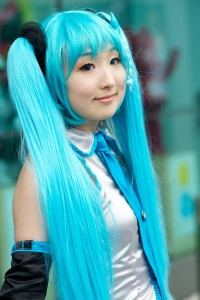
The 2012 J-Pop Summit Festival will be held in San Francisco’s Japantown August 25-26. (NEW PEOPLE, 2011)
d
By Lindsay Martell (Saitama-ken, 1995-1997) for JQ magazine. Lindsay is a freelance writer and a voice-over actor in Oakland, California. Visit her website here.
Whether you have a penchant for hunky Lelouch Lamperouge (the hunky antihero of the anime series Code Geass: Lelouch of the Rebellion) or a serious hankering for Lolita fashion, the pop-y, edgy, dynamic stuff you love is busting at the seams with this year’s J-Pop Summit Festival in San Francisco’s Japantown August 25-26.
With its campy theme of “Cyberpop Overload,” the second annual gathering is a Japanophile’s dream come true—noshing on chicken teriyaki bento or pork katsu curry from a JapaCurry food truck as you bop along to the scores of bands busting out tunes—this mecca of all things related to Japanese pop culture has something for everyone: fashion, film, anime, video games, technology and thumping music. And for JET alums who are feeling particularly natsukashii? Kite-kudasai!
Personally, I can’t wait. Not a day goes by when I don’t miss Japan. I haven’t lived there since the mid-’90s, when I was an ALT in Saitama, and yet, I can still feel the humid summer air, tatami beneath my feet, and the salty perfection of roasted senbei crunching in my mouth. At that time, I couldn’t get enough of the hypnotic pop scene. Most of it was a mere 1.5 hours away in Shibuya—a deliriously crazed hub of all things punk and pop.
And while I am now thousands of miles away from that edgy scene, J-Pop is an easy trip—a place brimming with kawaii-ness around every corner. More than 55,000 people got their pop on at the festival in 2011, and even more are expected to join in the fun this year.
JQ Magazine: JQ&A with Bridges to Japan Founder Jennifer Jakubowski
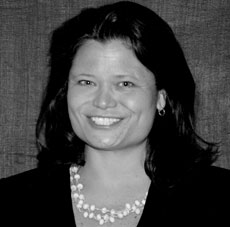
“If you are interested in doing something Japan-related, the JET alumni community is definitely a good start, associating with people who can relate to your experiences in Japan, and getting to know people who might be useful contacts for you on the career front.”
- space
- By Lana Kitcher (Yamanashi-ken, 2010-12) for JQ magazine. Lana is a New York native, and just recently returned to the U.S. She wrote for the AJET online magazine Connect while on the JET Program. She also enjoys writing about her adventures on her blog at Kitcher’s Café.
Jennifer Jakubowski (Hokkaido, 1995-97) is the founder and managing director of Bridges to Japan, a Japanese-American cross-cultural consulting and training firm based in New York. Prior to joining JET, Jakubowski spent two of her younger years in Japan, one as a junior high school student due to her father’s job and one as an exchange student at Waseda University.
Following her time on JET, she worked for the Nagano Winter Olympics as a broadcaster (despite having no experience or training, she wryly recalls), acquired a master’s degree in international studies and diplomacy in London, and then returned to the U.S. to chart a professional course in cross-cultural consulting in New York City. This mixture of experiences and opportunities over the years has landed her where she is today with Bridges to Japan.
As an inspiration to past, current and future JETs, JQ caught up with Jakubowski to learn about how she made it to where she is now, and what advice she has to offer to other JETs and alumni hoping to use their JET experience in their future careers.
Tell us a little about what you do at Bridges to Japan.
Most simply put, our mission is to help bridge cultural differences between Japanese and American business communities. As anyone who has spent time in both cultures can attest to, there are significant differences in how things are approached on many levels and these differences, if not addressed, can lead to misunderstandings. In the business world especially, this can have an adverse impact on the bottom line of a business initiative. Our end goal is for each side to better understand where the other side is coming from so that the relationship is more successful and enjoyable all around.
How do you achieve this?
For American clients, this most often involves training them on Japanese business and social norms unfamiliar to them if they haven’t had prior experience dealing with the Japanese culture. On the flip side, we work with Japanese expatriates in the U.S. (or on their way) to help them adapt to American workplace norms and to navigate working with locally hired American staff.
What kind of people or companies might be interested in your services at Bridges to Japan?
Any American organizations or individuals who are doing business with Japan, but who are unfamiliar with how to effectively navigate the cultural waters. It’s truly amazing the impact that even one day of training can have on the success of a particular business relationship. I hear it time and again from my clients. As you know, the Japanese don’t expect you to “be” Japanese—they even find it a little weird or unsettling when gaijin try too hard—but the effort to reach across the aisle and demonstrate some cultural compromise and sensitivity in the course of business can make or break a relationship. Likewise, Japanese expatriates working in the U.S.—or on their way to the U.S.—are ideal candidates for the type of support we provide.
How did your experience on the JET Program prepare you for, and lead you to where you are now?
In addition to certain aspects of business that I’ve learned through experience over the years, having a solid understanding of the Japanese culture is the single most important aspect of my work. By being exposed to so many situations and Japanese people on JET—speaking to senior citizen groups, teaching junior high school students, working with Japanese government officials, playing softball with local peers, volunteering at a special education program, riding tractors with local farmers…you name it—my cultural literacy escalated significantly. While the learning curve is infinite, I feel that the JET experience endowed me with significant knowledge on this front by mere virtue of what was expected of me in that capacity. I had a strong academic base and some prior experience in Japan going into the program, which certainly helped, but the range of things I experienced on the JET Program was really astounding. Once I had a solid understanding of these cultural differences and the value of applying this knowledge professionally, I’ve been hooked on applying it professionally ever since.
JQ Magazine: Film Review – ‘Love Strikes!’ Twice at JAPAN CUTS Film Festival
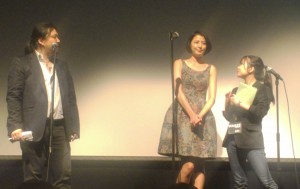
‘Love Strikes!’ star Masami Nagasawa, center, with JAPAN CUTS festival curator Samuel Jamier at Japan Society, July 14, 2012. (Shinobu Torii)
By Rick Ambrosio (Ibaraki-ken, 2006-08) for JQ magazine. Rick manages the JET Alumni Association of New York (JETAANY)’s Twitter page and is the creator of the JETwit column Tadaima!
Love Strikes! had its encore screening July 22 at Japan Society’s annual JAPAN CUTS film festival, and I can tell why they had to run it a second time: a main character with a wide range, beautiful girls, and the hilarious situations he gets himself into with them (though the funny stuff is a little frontloaded, but we’ll get to that).
Hitoshi Ohne’s Love Strikes! (or Moteki 「モ テキ」) is based on a manga of the same name and is the sequel to the popular television series. The main character, Yukiyo Fujimoto (Mirai Moriyama) is a young man entering middle age and finding his luck with women wanting. From out of nowhere, he has his moteki, or time of great popularity with women of the opposite sex, which is said to happen to a man just three times in his life.
The movie’s events find us after his first moteki, with Yukiyo wishing for another shot with a great girl. That great girl’s name is Miyuki (Masami Nagasawa), whom Yukiyo makes a connection with over Twitter. We then see our introspective thirty-something hero chasing her all over Japan, making laughs, breaking hearts, and learning through the whole process.
Justin’s Japan: Week Three of JAPAN CUTS 2012 Blasts Off with ‘Space Battleship Yamato’ Premiere
http://www.youtube.com/watch?v=Row0rYFQCHs
By JQ magazine editor Justin Tedaldi (CIR Kobe-shi, 2001-02) for Examiner.com. Visit his Japanese culture page here for related stories.
Japan Society’s annual JAPAN CUTS festival winds down this week with a sensational lineup of cinema and stars. The DON’T STOP! JAPAN CUTS Party follows the July 26 screening of Don’t Stop!, featuring an introduction with director Kenji Kohashi.and Leonie director Hisako Matsui for the July 27 screening introduction and Q&A.
DON’T STOP! documents the journey of “CAP,” a hard-as-nails 46-year-old man who realizes his lifelong dream, to go to America and ride a Harley down Route 66. CAP’s love affair with America and motorcycles began when he was young, but when he was 26, a traffic accident immobilized his left hand and lower body. Over the next 20 years, much of his life has been spent either in bed or in a wheelchair. In a 10-day, 4200 km trip across the U.S., encounters and miracles happen along the way to breathe fresh life into CAP and his friends.
Other highlights include Toshiaki Toyoda’s enigmatic terrorist art house gem Monsters Club (July 25); tthe world premiere of moral shocker Ushijima the Loan Shark (July 25), which features the impressive film debut of AKB48’s Yuko Oshima (recipient of the festival’s first-ever Cut Above Award for Outstanding Debut); Hisako Matsui’s haunting docudrama Leonie (July 27); and climaxes with the North American premiere of one of the highest-grossing Japanese films of all time, Space Battleship Yamato (July 28).
For this week’s list of films, click here.
JQ Magazine: Book Review – ‘Monkey Business Volume 2’
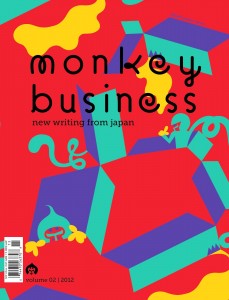
“Anyone can read this book and appreciate it. It provides a window into the heart, mind, and soul of the Japanese people following the tsunami, earthquake and nuclear disaster.” (A Public Space)
By Greg Anderson, (Fukuoka-ken, 1990-1992) for JQ magazine. Greg is part of the fourth class of the JET Program, which began in 1987. He is currently employed as an auditor with the U.S. Treasury Department and is a new member of the JETAA New York book club.
Monkey Business: New Writing from Japan is an anthology of opinions, thoughts, and stories written by some of the most prominent writers from the past and present on the subject of Japan and co-edited by Japanamerica author Roland Kelts (Osaka-shi, 1998-99). I love this book!
Why? Because anyone can read this book and appreciate it. You do not have to be an aficionado of Japan or, frankly, be able to locate it on a map. This book provides a window into the heart, mind, and soul of the Japanese people following the tsunami, earthquake and nuclear disaster. Just as in the United States following the events of September 11, 2001, Americans were forced to pause and consider American values, the American way of life and America’s relationship with rest of the world, along with what it means to be an American.
The events of March 11, 2011 were a watershed moment for the people of Japan. Nothing will ever be as it once was in Japan. The loss of life, failed technology, and deceit/lies are themes that are all addressed in this issue of Monkey Business, released earlier this year. What’s great about this book is that there are two ways that it can be read: You can read it chronologically from page one through page 210, you can browse the index to find an interesting story, or you can simply thumb through the book (like I did), find a story that strikes your fancy, and begin reading (I assure you that you will not be disappointed).
Justin’s Japan: Week Two of JAPAN CUTS 2012 Spotlights Late Film Legend Yoshio Harada

‘Shall We Dance?’ returns to the big screen July 21 as part of this week’s JAPAN CUTS offerings at New York’s Japan Society. (Daiei Co., Ltd )
By JQ magazine editor Justin Tedaldi (CIR Kobe-shi, 2001-02) for Examiner.com. Visit his Japanese culture page here for related stories.
This week, Japan Society’s annual JAPAN CUTS film festival pays tribute to the late actor Yoshio Harada, screening his final film Someday and 9 Souls, (both July 19). The festival also highlights the career of living legend Koji Yakusho, presenting five of his most inconic films over July 20-21: Chronicle of My Mother, Cure, Shall We Dance?, Toad’s Oil (which Yakusho also directed), 13 Assassins, and The Woodsman and the Rain.
Yakusho will be on hand for the Woodsman’s sold-out July 20 screening for an introduction, Q&A and reception. On that occasion, the festival will award the star the first ever JAPAN CUTS prize, the Cut Above Award for Excellence in Film. Yakusho will also appear for the July 21 screening of Takashi Miike’s hit samurai action movie 13 Assassins. Other highlights include Toshi Fujiwara’s provocative and poetic documentary on post-tsunami Japan No Man’s Zone (July 22, includes an introduction and Q&A with director Toshi Fujiwara).
Also, fans can enjoy encore screening of the irresistible blockbuster love comedy Love Strikes! (July 22). The film’s debut on July 17 welcomed a very special guest, Japanese Academy Award-winning actress Masami Nagasawa, who appeared following a live taiko performance by the legendary group Cobu.
For this week’s list of films, click here.
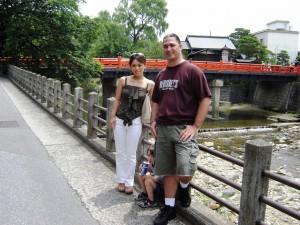 By John McGee (Nagano-ken, 2004-05) for JQ magazine. John is the Tampa Regional Representative for the Florida JET Alumni Association, and the founder of Tampa Natsu Matsuri, a free annual event organized by local residents with an interest in Japan.
By John McGee (Nagano-ken, 2004-05) for JQ magazine. John is the Tampa Regional Representative for the Florida JET Alumni Association, and the founder of Tampa Natsu Matsuri, a free annual event organized by local residents with an interest in Japan.
The balmy breeze blew in through the screened doors of our house, floating the sheer curtains in soft billows. Late May in southern Nagano is damp…it’s always damp on the wet side of the Alps. But being from Florida, this was comfortable weather.
My good friend was visiting from America. He’d made quite a stir in our sleepy town striding around with his seemingly angry Native American scowl way up there brushing two meters, from which nearly a meter of black tresses flowed down like raven waterfalls.
We were watching the shadows slip up the mountains across from our home when the phone rang. It was our friend Sayaka. “The fireflies are here!” she said excitedly. “Want to come see them?”
Sure we would. If they were as big as other Japanese bugs, this could be a great sight. She told us where to meet her, so we carefully folded my wife, my three-year-old son, our giant Indian friend Bass, short for Sebastian, and myself into our Toppo and sputtered down our ski jump of a street to the main road.
We soon pulled up to the intersection where Sayaka was waiting. This miniaturized beauty stood out in our town every bit as much as Bass. She was dressed to kill as always, standing next to her shiny new Cube. Her family owned a ryokan and she had been all over the world. She quickly waved us to get going and we followed her down out of our crevice of a valley into the wider spot where a smaller river joined the local Kiso River, forming a rare broad flat spot.
This area was checkered with small rice fields and ancient farm houses. As we neared the junction of the rivers I started to see quite a few cars. I was a bit surprised, but that quickly turned into open-mouthed shock as we saw that there was not one available place to pull off the road for nearly a kilometer! Lightning bugs were apparently a big attraction in this sleepy town. Sayaka spotted a driveway open at a farmhouse and told us she’d ask if we could park there. “That’ll never work,” I thought, but of course this was Japan, so in a moment we were parked in the best spot on the field.
We stepped out into a dusky green sward dotted with families. Children hopping here and there. Some had jars. Others had nets. Some just walked along with heads back and mouths agape. Against the black silhouettes of the steep mountains there were literally thousands upon thousands of small bright lights flashing as high up as I could see. In answer, the rice and grasses along the river were twinkling like Christmas lights.


